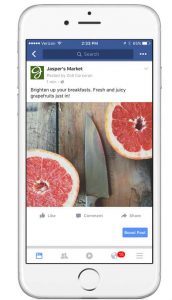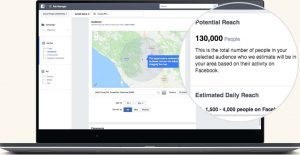 Did you know that Facebook advertising has been available for 13 years? The first paid promotions appeared in April 2004, just two months after the social network launched. And now in 2017, it’s an essential part of growing your business. Understanding how to use Facebook Boosted Posts versus Adverts has never been more important in making sure you use the right strategy to get the best return on your investment.
Did you know that Facebook advertising has been available for 13 years? The first paid promotions appeared in April 2004, just two months after the social network launched. And now in 2017, it’s an essential part of growing your business. Understanding how to use Facebook Boosted Posts versus Adverts has never been more important in making sure you use the right strategy to get the best return on your investment.
Until fairly recently, it was still possible to grow your following for free. Posting great content on a regular basis and using all of the standard social tools was a viable way to build your audience. As more and more companies jump into social media marketing, it’s become tougher to stand out. The influx of promotional posts mean Facebook has lowered the amount of organic reach you can get in the main Newsfeed, even among people who already like your Facebook Page.
Since the first advertising banners appeared on Facebook, the number of ways you can pay to promote your business has expanded rapidly. New ways to target potential customers are appearing all the time. And while it can be useful, it’s also overwhelming when you first start spending money to grow your company.
Why Invest in Facebook Advertising?
It’s no secret that Facebook is massively popular. But it’s worth repeating some of the statistics. For example, the average amount of time spent on Facebook, Instagram and Messenger is 50 minutes per day. That’s almost as much time as spent eating and drinking. And more than double the next most used site, YouTube.
In the UK, social media sites have a reach of 97.6% for a Millennial audience, and 94% for those aged 35+. And in both cases, Facebook is the leader by far. So to be found on the site people use most on desktop and mobile, you need to be effective at promoting yourself on Facebook.
If you need more convincing, check out this detailed explanation of the power of Facebook Advertising.
While there are 65 million businesses using Facebook Pages in total, only around 5 million are using advertising. That may be a big number, but spread around the globe, it means a good chance smaller and local competitors haven’t begun to spend money on improving their performance yet. Which means an effective strategy starting now will give your business a headstart. The key difference in results comes from understanding what you want to achieve and the best way to do it.
What Are Facebook Boosted Posts?
If you manage a Facebook Page, you’ve probably spotted the option to ‘Boost Post’. This appears on any content you publish on your page, to quickly promote it. By default, your post will appear in the Desktop and Mobile Newsfeed on Facebook with the tag ‘Sponsored’.
 Until recently, the ways to target a Boosted Post were very limited. But you’re now able to go beyond just Gender, Age and Location. The Detailed targeting will now let you include or exclude all of the options Facebook offers for Demographics (e.g. work, relationship, parents, or life events such as a new job or recently moved), Interests (Action films, Italian Cuisine or Gardening, for example), Behaviours (Gives to charity, plays console games, or Early technology adopters), and various Facebook defined groups under More Categories.
Until recently, the ways to target a Boosted Post were very limited. But you’re now able to go beyond just Gender, Age and Location. The Detailed targeting will now let you include or exclude all of the options Facebook offers for Demographics (e.g. work, relationship, parents, or life events such as a new job or recently moved), Interests (Action films, Italian Cuisine or Gardening, for example), Behaviours (Gives to charity, plays console games, or Early technology adopters), and various Facebook defined groups under More Categories.
You can also upload a remarketing list to create a Lookalike Audience which matches existing visitors to your website.
The rule is that a Facebook user has to match at least one specific detail to be shown the Boosted Post. So for example, if you like Action films, Italian Cuisine, or Gardening, you’ll see it, rather than having to like all three.
Now set your budget, how long you’d like it to be a Boosted Post, and payment details. However, there are some limitations, such as not being able to target or exclude people who already like your page, or are connected to your existing fans. If you would like to do this, you will need to use Facebook’s Advertising management tools for engagement.
The key thing to remember about Facebook Boosted Posts is that they will always be automatically optimised to get the most engagement with your content. That means Facebook will try to get you the most views, likes and comments.
What About Facebook Advertising?
If Boosted Posts are the start, then mastering Facebook Advertising is the advanced class. You’ll see this from the wide range of marketing objectives available for creating your first ad. These can include awareness and engagement, but also cover lead generation, conversions, product catalogue sales and even store visits.
 Before you move onto creating one or more adverts and defining your audience, there’s now an option to create a split test between advert sets. This means you can compare different target audiences more easily by running the same group of ads and seeing what performs best.
Before you move onto creating one or more adverts and defining your audience, there’s now an option to create a split test between advert sets. This means you can compare different target audiences more easily by running the same group of ads and seeing what performs best.
You’ll now get the same targeting options for demographics etc. Plus the Connections options to include or exclude existing page fans, or people who have already engaged with your event or mobile app.
The selection does change slightly depending on your marketing objective. But the mechanics are the same whether you’re aiming for reach or conversions.
Finally there’s the advert creation, including the format, any included media, and which links you’d like included. You can pick from an image, single video, or a looping slideshow of multiple images. While the slideshow tops out at 50 seconds, the video ads can run as long as 60 minutes as long as the file size is small enough.
Choosing Boosted Posts Versus Adverts:
So which promotion option should you choose? The answer is to use the one which matches your objective most closely. Many people, including myself, have tested both options over a number of months and years.
 As Boosted Posts provide maximum engagement with your content for the lowest cost, they get a bigger reach with your existing audience than Facebook Adverts.
As Boosted Posts provide maximum engagement with your content for the lowest cost, they get a bigger reach with your existing audience than Facebook Adverts.
But Facebook Advertising gives you a wider range of objectives. This allows the social network to optimise your ads for people to Like your page, click on a link to your website, or convert a sale. This is their real strength over Boosted Posts, along with more refined targeting abilities.
So if you want people to take a defined action as part of your Facebook promotions, then it’s obvious you’ll want to choose Advertising.
[bctt tweet=”Knowing whether to Boost Posts or Advertise is essential for Facebook success” username=”yellbusiness”]
Hopefully that’s explained the main points and differences when it comes to Facebook Boosted Posts versus Adverts. In the majority of cases for business needs (finding relevant potential customers, driving clicks to your website), Facebook Advertising is the superior option to grow your brand awareness, traffic to your website and Facebook Page likes to a targeted and relevant audience. But a quick and cheap Post Boost can be valuable to get an existing message to a wide audience. Many of the brands I work with use a combination of the two options. It really depends which objectives they want to achieve for particular pages or content.
This doesn’t mean you can skimp on publishing great content organically, engaging with your Facebook community, or responding promptly to enquiries. And you should still make sure you’ve tweaked your Facebook Page settings regularly for the best results.
Combine good set-up with great content and well-planned advertising and you’ll be well on the road to Facebook success.





